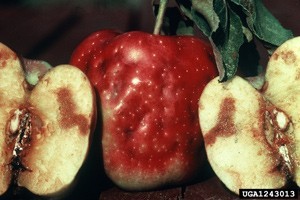Apple maggots are legless, yellow-white in color and about 1/4 inch to 3/8 inch in size. Maggots hatch from eggs laid on the fruits by the parent flies. The mature maggots fall to the ground where they pupate and overwinter and emerge as adult flies the following June. The parent flies are slightly smaller in size than a housefly, dark in color and have transparent wings with dark bands. Apple maggots are found throughout the northern and central regions of the United States.
Apple maggots feed on apples, pears, blueberries and occasionally plums and cherries.
Pits and dimples form on the surface of fruit from egg laying that results in misshaped fruit. Maggots tunnel through the flesh of fruit, leaving a brown trail of decay and causing it to drop prematurely.

About The Author: Ellen Brown is an environmental writer and photographer and the owner of Sustainable Media, an environmental media company that specializes in helping businesses and organizations promote eco-friendly products and services.
Add your voice! Click below to comment. ThriftyFun is powered by your wisdom!